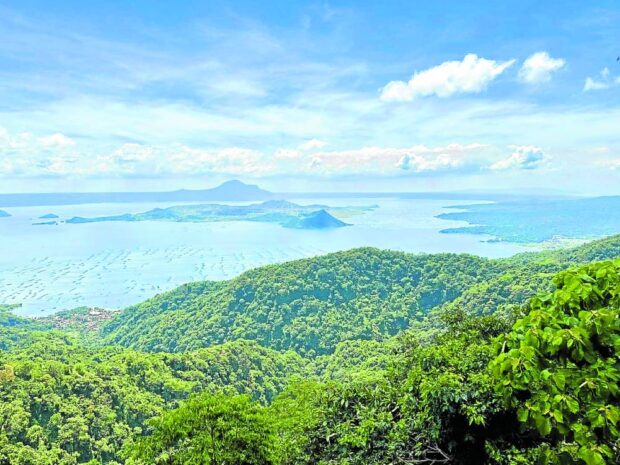Taal Volcano’s sulfuric gas emission wanes

Taal Volcano looks serene in this photo taken from Tagaytay City. FILE PHOTO
LUCENA CITY — After spewing an alarming high volume of sulfur dioxide (SO2) early this week, the Taal Volcano in Batangas province has released significantly less harmful gas compared to previous emissions, according to the latest bulletin from the Philippine Institute of Volcanology and Seismology (Phivolcs).
On Saturday, Feb. 24, the Phivolcs reported that 7,519 metric tons (MT) of SO2 from Taal’s main crater was measured over the past 24 hours and rose to 900 meters high before drifting southwest.
The latest emission level was a significant drop from the 9,510 MT of SO2 logged on Feb. 21 and 22, which was preceded by 14,211 MT recorded on Feb. 19 and 20, the second highest this year.
From Jan. 25 to Jan. 28, the volcano released 15,145 MT of the hazardous gas, the highest record so far this year.
READ: Taal Volcano emits record-high sulfur dioxide; Alert Level 1 stays
Article continues after this advertisementOn Nov. 23, the volcano logged 11,499 MT, the highest emission recorded in 2023.
Article continues after this advertisementIn its advisory on Feb. 19, the Phivolcs reported that Taal Volcano has been releasing an average of 10,000 MT daily since January this year and has been continuously degassing voluminous concentrations of SO2 since 2021.
However, volcanic earthquake activity has remained weak with only 17 volcanic earthquakes recorded so far this year.
The Phivolcs reported that moderate winds have prevented the accumulation of SO2 and no volcanic smog or vog over the Taal Caldera was observed by visual monitors throughout the monitoring period.
READ: Phivolcs detects increased Taal Volcano sulfuric gas emission
Vog contains acidic volcanic gases like SO2 in fine droplets, causing eye, throat, and respiratory irritation. Severity depends on gas concentrations and exposure duration.
However, Phivolcs warned that degassing of high concentrations of volcanic SO2 “continues to pose the threat of potential long-term health impacts to communities around Taal Caldera that are frequently exposed to volcanic gas.”
The Phivolcs maintained the alert level 1 status of Taal Volcano, which means that phreatic eruptions, volcanic earthquakes, thin ash falls and hazardous gas emissions may occur.
The agency has also cautioned the public against going to Taal Volcano Island, locally known as “Pulo,” and prohibits aircraft from flying near the crater.